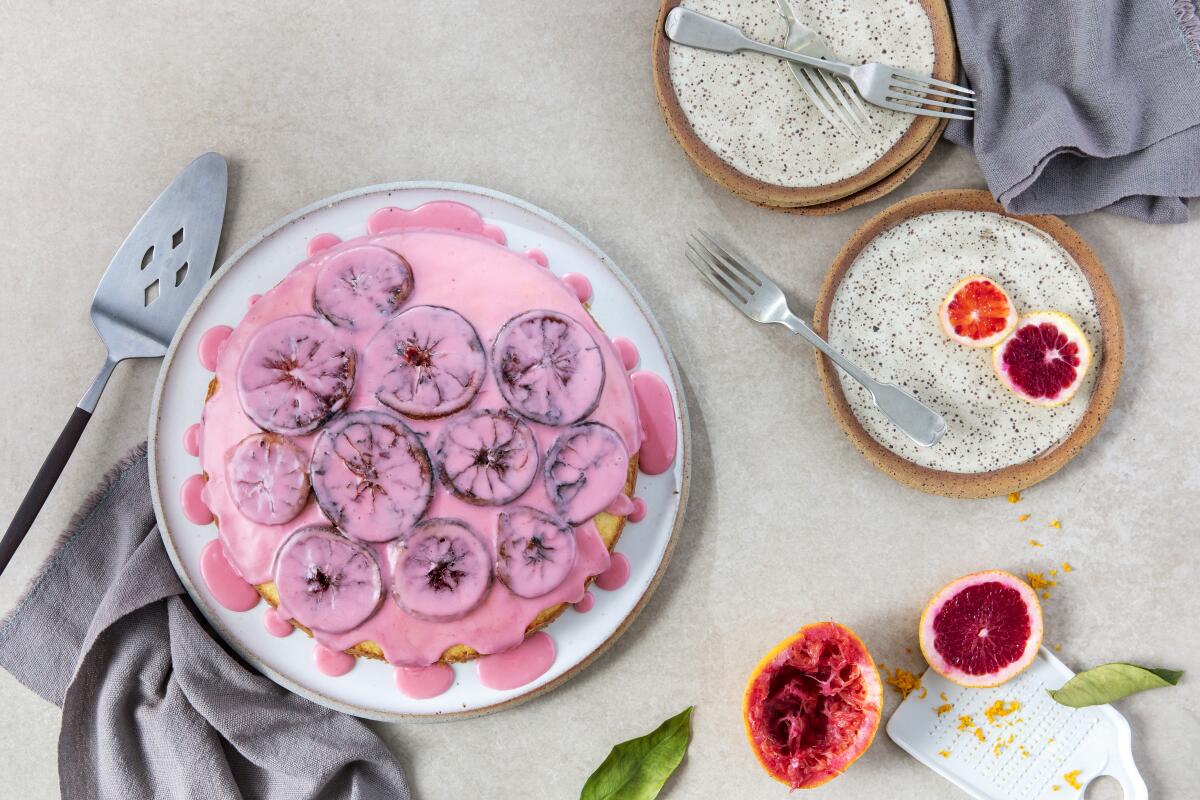A bloody good citrus cake that uses the whole fruit

- Share via
My favorite fruit this time of year is any of the different kinds of orange citrus: blood oranges, mandarins, clementines. But I tend to buy too many at the market. After making more jars of marmalade or whole candied oranges than I’ll ever use, I always turn to baking cakes.
In an effort to use the whole fruit — my favorite trick to cut down on food waste — I came up with this cake that uses the zest in the batter and whole slices, pith and all, as decoration on top. When fried in butter, the slices caramelize like creme brûlée and stay sweet thanks to a brief poach in fresh juice.

The single-layer cake is an easy butter-based one, but once the fried slices are arranged on top and anchored in place with a bubblegum-pink glaze, it transforms from a sweet confection into a nuanced, grown-up treat: sweet and floral with a welcome hit of bitterness and tartness from juice left in the slices. It’s the perfect afternoon wedge with coffee or tea — or leave off the glaze and eat it for breakfast. It’s a new showcase for my favorite citrus that doesn’t require gazing at it through syrup in a glass jar.

Fried Blood Orange Cake
1 hour 15 minutes. Serves 8 to 10.
Mandarins, clementines or other small orange citrus work great in this recipe too. Those with thinner piths will cook quicker so keep your eye on them as they fry in the butter, and lower the heat if it looks as if they might begin to burn.
Ingredients
- 4 small blood oranges or navel oranges (14 to 16 ounces total)
- 1/2 cup plus 2 tablespoons unsalted butter, at room temperature, plus more for greasing
- 1 1/2 cups all-purpose flour, plus more for the pan
- 1 cup granulated sugar
- 1 teaspoon baking powder
- 1/2 teaspoon kosher salt, plus more
- 2 large eggs
- 1/2 cup whole milk
- 1 cup powdered sugar, sifted
Instructions
- Using a Microplane zester, finely grate the zest from all 4 oranges, letting it fall into a large mixing bowl. Halve 2 of the zested oranges crosswise then squeeze out all their juice into a liquid measuring cup; pour ¼ cup into a small bowl and 2 tablespoons into another bowl (drink any remaining juice right now). Trim and discard the ends from the remaining 2 oranges and slice into ¼-inch-thick rounds (5 to 6 per orange). Cover each bowl of juice and the slices with plastic wrap and reserve until ready to use.
- Heat the oven to 325 degrees. Grease the bottom and side of a 9‐inch springform pan and dust with flour, tapping out the excess.
- To the bowl with the orange zest, add ½ cup butter, the sugar, baking powder and salt and beat on medium speed of a mixer until light and fluffy, about 3 minutes. Add the eggs, one at a time, beating well between each addition. With the mixer on low speed, add half the flour, followed by all the milk, and then the remaining flour, stopping when the batter just comes together. Use a rubber spatula to scrape down the bottom and side of the bowl to make sure the batter is evenly mixed.
- Scrape the batter into the prepared pan and smooth the top. Bake until the cake is golden brown on top and a toothpick inserted in the center comes out clean, about 40 minutes. Remove the pan from the oven and let the cake cool for 10 minutes, then unmold its sides.
- While the cake bakes, fry the orange slices: Heat the remaining 2 tablespoons butter in a large nonstick skillet over medium heat until it starts to foam. Add the orange slices in a single layer, sprinkle with a pinch of salt and cook, flipping once halfway through, until very soft and caramelized and the pith is tender, about 6 minutes. Pour in the ¼ cup reserved orange juice and continue cooking until reduced to a syrupy consistency, about 45 seconds more. Remove the skillet from the heat.
- Using a fork, gently lift the orange slices out of the pan and arrange them over the top of the cake (there will be gaps; don’t stress over it). In a large bowl, combine the powdered sugar with 1 tablespoon reserved juice. Continue adding the remaining tablespoon of juice by the teaspoon until the icing has thinned to a thick but pourable consistency.
- Pour all the glaze in the center of the cake at once, then use a spoon to gently coax the glaze over the orange slices and top of the cake, letting it drip down the sides naturally. Let the cake cool completely to allow the glaze to set before serving. Use a serrated knife to cut through the slices easily.
More to Read
Eat your way across L.A.
Get our weekly Tasting Notes newsletter for reviews, news and more.
You may occasionally receive promotional content from the Los Angeles Times.











